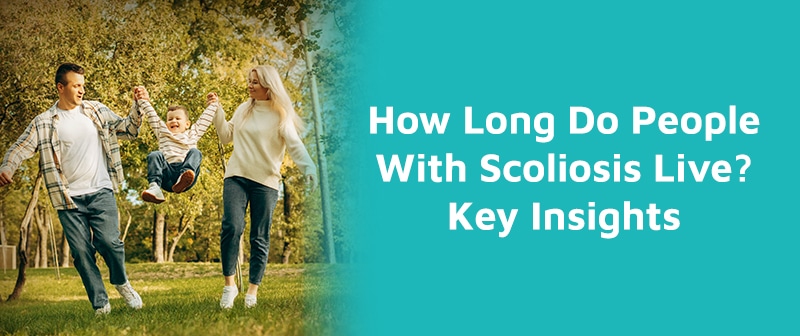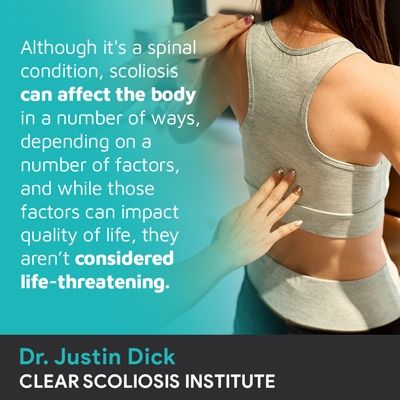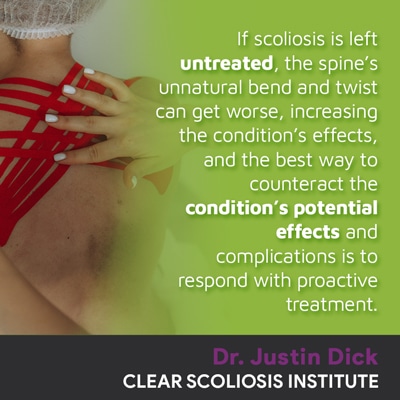
No two cases of scoliosis are the same, but generally, the more severe a condition, the more likely it is to impact quality of life; even in severe cases, a lower life expectancy isn’t considered a common condition effect.
In most cases, scoliosis patients have a typical lifespan, but there are certainly condition effects that can impact quality of life, and as a progressive condition, it needs to be proactively treated to prevent potential complications.
Scoliosis is a spinal condition that causes an unnatural sideways-bending and rotating spinal curvature to develop.

And while a diagnosis of scoliosis can mean potential changes to posture, movement, and pain, many of these effects may be prevented with a proactive treatment approach.
As people with scoliosis don’t have lower life expectancies than those without, let’s discuss the symptoms of scoliosis capable of disrupting a patient’s quality of life.
Scoliosis symptoms are shaped by a number of factors from patient age to condition type, severity, and location within the spine.
Patient age is an important factor when it comes to pain and progression.
Scoliosis isn’t always painful, particularly for children; the condition doesn’t become compressive until growth has stopped, but pain is a common symptom of adult scoliosis.
In fact, radiating pain is what brings most adults in for an initial assessment.
Scoliosis pain can involve the muscles, the back, and radiating pain due to compressed nerves, and remember, as a progressive condition, if scoliosis is getting worse, its effects are too, including pain.
Scoliosis ranges from mild to moderate and severe, so while pain might not be overly disruptive at the mild level, the more severe it becomes, the more it can affect quality of life.
Postural changes are the main symptoms of childhood scoliosis, with the earliest signs often involving uneven shoulders and hips.
The main age group affected by scoliosis are adolescents, diagnosed as adolescent idiopathic scoliosis, so let’s take a minute to talk specifically about quality of life within this age group.
Adolescent idiopathic scoliosis is most often diagnosed between the ages of 10 and 18, and as scoliosis progression is triggered by growth, this age group is at risk for rapid progression.
The stage of puberty involves rapid and unpredictable growth spurts that can change quality of life quickly if they’re not being counteracted with treatment, and the more conditions progress, the more complex they are to treat.
So early postural changes can involve uneven shoulders, shoulder blades, hips, an uneven waist, an arch in the rib cage, and a noticeable lean to one side.
Considering how self conscious and body-image driven a typical teenager can be, consider the potential effect of being diagnosed with a progressive spinal condition that can set them apart from their peers.
As scoliosis progresses, the size and rotation of the sideways-bending curve is increasing, and as the spine is shifting further out of alignment, the body is becoming more asymmetrical, and this can start to disrupt movement; changes to balance, coordination, and gait can also be expected.
Particularly for adolescents who define themselves by their athleticism, a scoliosis diagnosis that comes with activity restrictions can affect overall enjoyment of life, confidence, and mental health.
Because adolescents can progress so quickly, there are a lot of benefits associated with early detection followed by a proactive treatment response, although results can never be guaranteed.
While scoliosis is capable of causing symptoms that can affect a patient's overall quality of life, a key insight is that in many cases, effects can be minimized and prevented, but what happens if scoliosis is left untreated?
As mentioned, many cases of scoliosis are highly treatable, and this means reducing the size of the unnatural spinal curve and restoring the spine and body’s balance and stability.
But if scoliosis is left untreated, as a progressive condition, it’s likely to get worse at some point, and in these cases, complications can develop.
Complications can include chronic pain, digestive issues, cardiac and lung issues, and while particularly in atypical cases, these can be severe, these effects are still not closely associated with a reduced lifespan, but they are capable of disrupting quality of life.
Particularly in adults, untreated scoliosis can cause chronic pain as the spine becomes increasingly unstable, and in older adults with degenerative scoliosis, this does put them at a greater risk of injury through a fall.
Digestive issues can develop due to compression of organs involved in the digestive process and nervous system issues caused by the nerves within the spine being compressed.
Lung impairment and cardiac issues are most common in cases of levoscoliosis, where the unnatural spinal curve bends towards the heart, to the left; in typical cases of idiopathic scoliosis, curves bend away from the heart.
Thoracic scoliosis is also the most closely associated with lung and cardiac issues because the thoracic spine is the only spinal section that attaches to the rib cage, so a common effect is the development of a rib cage arch (one side of the rib cage protrudes more than the other side).
Changes to the rib cage’s position can mean compression of the chest and organs within, including the lungs and heart, and this can mean less space for them to function within.

Proactive Nonsurgical Treatment
Scoliosis can be highly treatable, and with successful treatment results comes the knowledge that not only can a positive quality of life be maintained, but dreams can still be fulfilled.
It’s important for young people recently diagnosed to know there are a number of celebrities and professional athletes that thrive in their careers despite being diagnosed with scoliosis in childhood.
Proactive nonsurgical treatment is started immediately following a diagnosis, and this is because we want to start working towards improving the condition while curves are still small and malleable.
Scoliosis progression makes the spine more rigid and less responsive to treatment, and as postural changes such as uneven hips, shoulders, and the development of a rib cage arch develop, these changes get more difficult to reverse the more severe they are and the longer they're established.
Nonsurgical treatment has the goal of restoring as much of the spine's natural curves as possible. It includes condition-specific chiropractic care that can work towards manually adjusting the affected vertebrae so the spine is more aligned.
Once structural changes within the spine are made, the changes have to be supported by the spine's surrounding muscles; therefore, physical therapy and scoliosis-specific exercises can help balance and strengthen the core muscles.
In order to correct scoliosis, a number of treatments have to be combined, and conservative treatment is integrative. In addition to chiropractic care and physical therapy, corrective bracing can also be used in nonsurgical treatment, particularly in the treatment of childhood scoliosis.
Respiratory problems and cardiac issues capable of causing lower life expectancy are rare in scoliosis patients, and as mentioned, are the most likely to develop in atypical cases and/or scoliosis that's left untreated.
Conclusion
So most people with scoliosis don't have a lower life expectancy than those without the condition, but if left untreated, complications capable of disrupting quality of life can develop.
If untreated, scoliosis becomes very severe and requires surgical treatment, scoliosis surgery comes with its own potential risks, side effects, and complications.
When treated proactively, scoliosis can be highly responsive and treatable, with many cases not requiring any type of surgical treatment.
People with scoliosis that's untreated can live with increasing postural changes, movement changes, and pain. Those who are proactively treating their conditions can experience motivating effects like curvature reductions and postural improvements.
Here at the CLEAR Scoliosis Institute, as well as, Dr. Dick’s practice, CLEAR Life Scoliosis Reduction & Chiropractic, a conservative nonsurgical treatment approach is applied with the goal of managing progression, reducing the curve on a structural level, improving the spine's surrounding muscle balance and strength for more support, and rehabilitating the spine.
A misaligned spine can mean a misaligned body, and this can cause a number of effects felt throughout and should be taken seriously.

CLEAR provides a unique and innovative way of understanding scoliosis. Sign up to receive facts and information you won’t find anywhere else.
